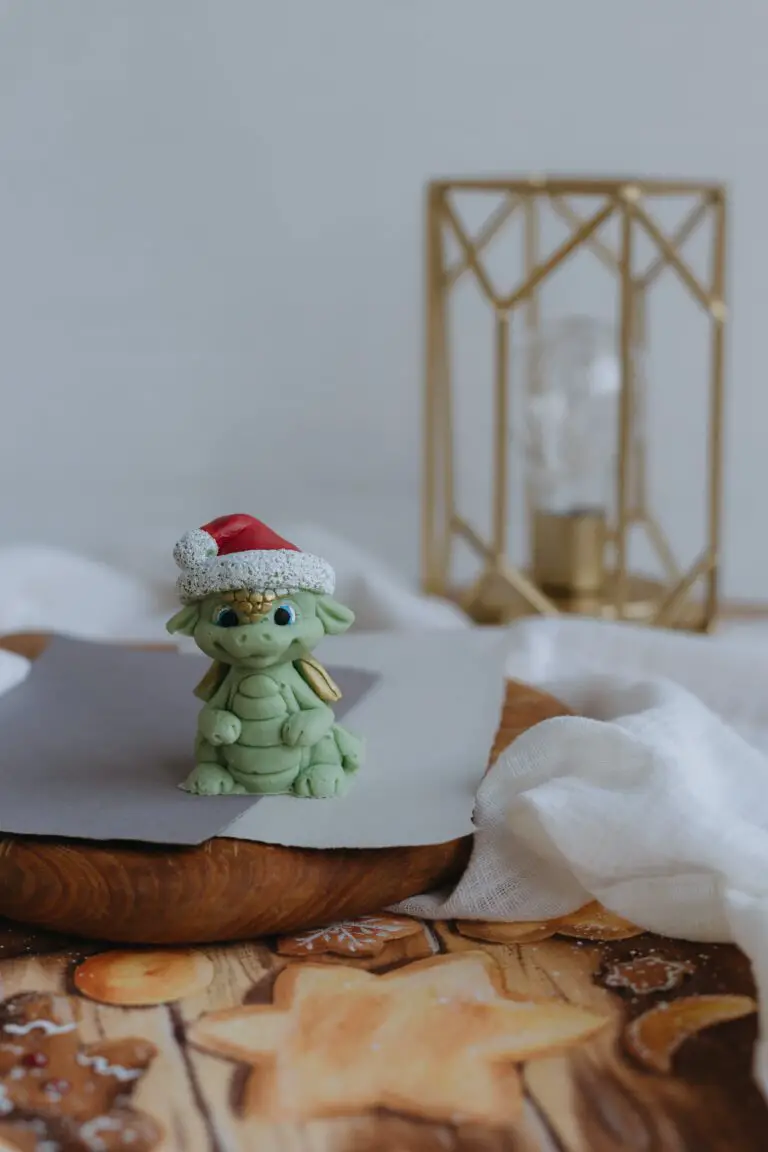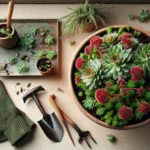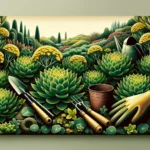Introduction to Blood Dragon Sedum
Welcome to the vibrant world of Blood Dragon Sedum, an eye-catching marvel in the realm of succulents. If you’re charmed by the idea of a low-maintenance yet visually striking plant, then you’re in for a treat with this unique variety. Picture this: fiery red tips that blaze like the scales of a mythical dragon, paired with a lush, green base that could rival any medieval forest the fabled creatures might call home.
Imagine walking through a garden where these succulents are used as living borders or groundcovers; their dramatic hues painting a picturesque scene. It’s not just a visual delight—the resilience of the Blood Dragon Sedum means it can thrive even in those spots where other plants might surrender to challenging conditions. Isn’t it fascinating how such beauty can arise from adversity?
You don’t have to be a green thumb expert to cultivate these rugged beauties. In fact, even beginners find them a joy to grow. Picture a bustling, sunny market square, alive with activity, much like how this resilient succulent flourishes in full sun environments, teeming with life and energy.
Now, let’s delve a bit deeper into the care aspects. A reliable resource on how to nurture your Blood Dragon Sedum is invaluable, offering insights that ensure your succulent doesn’t just survive—it thrives. And when you’re keen to expand your succulent collection, consider exploring other types and their care on our site; it’s a fountain of knowledge for the passionate plant enthusiast.
Here’s a glimpse into the world of the fascinating Blood Dragon Sedum, a perfect starter for our deep dive:

Stay tuned as we unearth the hidden delights of this dragon-esque flora and share expert tips that will help your Blood Dragon Sedum reach its majestic potential. Let the journey begin!
Blood Dragon Sedum Secrets: Thriving Tips for Your Succulent
Origins and Characteristics
Dive into the history of the Blood Dragon Sedum and explore its distinctive characteristics, such as its red-tinged leaves and hardiness. This succulent, scientifically known as Sedum spurium ‘Dragon’s Blood’, bursts onto the scene each year with an allure as mythical as its name suggests. Tracing its origins to the hilly landscapes of the Caucasus, its fiery foliage has painted gardens across the globe with vivid strokes of crimson and green. Imagine a groundcover reminiscent of a dragon’s back—scales flushing red against hard-edged rock, basking in the sun.
Admired for its adaptability, the Blood Dragon Sedum thrives even in the rocky, draughty crannies of your garden where other plants might wither. These resilient plants make a statement with their richly tinted leaves that transition from a glossy green to a blazing scarlet with the onset of cooler weather. In summer, clusters of starry flowers invite a bustling hive of pollinators, creating a micro-ecosystem right in your backyard! It’s a real-life example of nature’s tenacity, where the toughest conditions birth the most stunning survivalists.
What sets the Blood Dragon Sedum apart is not just its drought tolerance, but its role in eco-friendly landscaping. A champion of xeriscaping, this succulent requires minimal water, making it a gem for sustainable gardens. Its robust nature allows it to fend off pests like aphids, who favor less spicy fare than the sedum’s sap. Yet, it isn’t invincible; excessive moisture can be its downfall, warranting attentive care and proper watering practices.
For enthusiasts eager to dive deeper into their succulent journey, pay a visit to The Ultimate Guide to Succulent Soil – an internal guide that doesn’t just scratch the surface but dives into the very bedrock of successful succulent care. It’s one more step towards mastering the art of cultivating these living gems.
Fascination with the Blood Dragon Sedum extends beyond its alluring appeal and into realms where only the hardiest dare to root. It’s a testament to nature’s resilience and a reminder that sometimes, the most spectacular beauty can be found in the most unexpected places.
Ideal Growing Conditions
Embark on a succulent adventure and unlock the vigor of your Blood Dragon Sedum! This captivating plant is not merely a sight to behold; it’s the treasure trove of the garden world, yearning for its perfect habitat. Let’s get you equipped to cultivate a throve of these dragon emblems with gusto!
First off, envision the Blood Dragon Sedum as the little dragon of your garden — a legendary creature that flourishes in a lair made just for it. The soil is the foundation of this lair. Aim for a gritty, well-draining medium that prevents the roots from waterlogging — if they get too damp, your precious dragons might become frail. A mix of sandy soil, peat, and perlite will provide a stronghold fit for dragon royalty.

Next, let’s talk sunlight, the fire in which your Blood Dragon Sedum forges its strength. These succulents demand a good bask under the bright rays, thriving on at least six hours of sunlight each day. Place them where the sun can cast its unwavering gaze, ensuring your plants can photosynthesize mightily. However, be wary of the scorching midday sun in hotter climates — it’s the dragon’s fiery breath that can singe their majestic foliage.
Preferred Climate for Blood Dragon Sedum
As for the climate, your verdant dragon favors the temperate realms but possesses a commendable resilience to the whispers of the cold, down to about -30 degrees Fahrenheit. That being said, they don’t take kindly to being blanketed in snow for extended times. If your land is known for its frosty whispers, consider a guardian shelter for these succulent beasts during the winter’s peak.
In the throes of summer, your Blood Dragon Sedum will yearn for a gulp of water only when the soil is dry to the touch — perhaps a weekly ritual at most. This infrequent watering mimics the arid climates they’ve evolved to conquer, making them a formidable force against drought.
By understanding these guidelines, your Blood Dragon Sedum will not only survive but will reign supreme in its garden kingdom. Provide the right soil, generous sunlight, and proper watering, and these stoic plants will reward you with a spectacle of growth that echoes the legends of dragons from eons past.
Planting and Propagation Techniques
Are you ready to get your hands dirty with the Blood Dragon Sedum? This stunning succulent, known for its deep crimson foliage that practically bleeds vibrance into any garden, isn’t just a pretty face; it’s a hardy grower that expands your green collection with ease. So, let’s dive into the nitty-gritty of planting and propagating this dragon of the plant world!

First things first, let’s talk about planting. Selecting the right spot is key – think bright indirect light and well-draining soil. Blood Dragon Sedum isn’t fussy, but if you want it to really show off, these conditions are non-negotiable. Imagine it basking in the dappled sunlight, as if it’s lounging on a beach in the Mediterranean.
If you’re more of a propagation prodigy, you’ll be thrilled to know that the Blood Dragon Sedum propagates like a dream. Take a leaf or stem cutting, let it callous over for a day or two like a good scab, and then gently place it on top of succulent soil. With consistent moisture and patience, soon you’ll have little dragonettes sprouting. It’s like watching a mythical creature multiply before your very eyes!
Don’t forget the water – while this sedum is drought-tolerant, it appreciates a drink when the soil is dry. Imagine you’re the bartender, and the Blood Dragon Sedum is your most regular patron. Just keep the watering can handy and your succulent happy. And if you’re curious about other succulent types that can complement your Blood Dragon Sedum, take a glance at this comprehensive guide that touches on the diversity of succulents.
Every gardener knows, to really thrive, all succulents need some personal space – this one’s no different. Space out your Blood Dragon Sedum babies to give them enough room to spread their wings, er, leaves. It’s like ensuring each dragon has its own lair to grow treasure – in this case, more lush, red leaves.
Now you’re equipped with the wisdom to plant and propagate Blood Dragon Sedum with confidence. Get ready to watch your succulent collection soar to new heights with these captivating crimson beauties!
Common Pests and Problems
Gardening is not just about the sunny days and the blooming beauties; it’s a heroic battle against the tiny troublemakers that seek to besiege your beloved greens. Yes, we’re talking about the pests and problems that may target your Blood Dragon Sedum. Worry not, dear green thumbs, for I’m about to arm you with the knowledge you need to defend your succulent sentinel!
Imagine, if you will, a day when you stroll out to your garden, a warm cup of coffee in hand, only to find your Blood Dragon Sedum looking a little less dragon-like and a little more damsel-in-distress. It’s the aphids, mealybugs, or spider mites—those notorious ne’er-do-wells—that have come to feast. Aphids act like miniature vampires, sucking the life juices straight out of your plant’s leaves, while mealybugs cloak themselves in a cotton-like fortress, siphoning sap at their leisure. And spider mites? They’re the silent assassins with a penchant for weaving tiny webs of destruction.
But fear not! As with any good quest, there’s a way to combat these miniature monsters. Take aphids, for example—blast them with a strong stream of water, or for an organic fix, introduce ladybugs to your garden, who see aphids as a sumptuous buffet. Mealybugs will cower in the face of a cotton swab dipped in rubbing alcohol, and spider mites detest the mist from a spray bottle filled with water and a drop of dish soap as much as they hate a boost of humidity.

It’s not just the tiny crawlies you need to watch out for; environmental factors can also play the villain. Overwatering is like opening the floodgates to root rot—a fate most gruesome for our succulent friend. The secret to avoiding this watery demise is simple: a well-draining soil mix and a pot that lets the excess run free. Contrastingly, too little water will leave your Blood Dragon Sedum gasping for moisture, its leaves shriveling up like ancient scrolls. Remember, balance is key—water well, but let the soil dry out between those thirst-quenching sessions.
Then there’s sunburn. Yes, even dragons can get burned, and your Blood Dragon Sedum is no exception. Too much direct sunlight can scorch its leaves, leaving behind a mark as if a rival dragon breathed fire upon it. The solution is as clever as it is simple: provide some shade during the most scorching hours of the day. A strategically placed umbrella or a sheer curtain can be the shield that guards the realms of your sedum.
With these protective strategies, your Blood Dragon Sedum will continue to thrive, its fleshy leaves and warrior-like stature a testament to your guardianship. So, go forth, brave gardeners, and may your green kingdoms prosper!
Designing with Blood Dragon Sedum
Unleash the fierce elegance of Blood Dragon Sedum into your garden, where its bold textures and vibrant colors can steal the spotlight. Imagine the rich, dragon-scale-like leaves adding a mythical aura to your outdoor space. Let’s dive into the ways you can incorporate this striking succulent into your landscape or interior, turning the ordinary into the extraordinary with a touch of creative magic.
Firstly, consider the garden borders. Planting Blood Dragon Sedum along the edge of your flower beds can create a dramatic contrast against softer, flowing greenery. The succulent remains stout and robust, presenting an almost militant stance, ready to defend its blooming comrades from the encroachments of the mundane lawn.
What about pairing it with other plants? The architectural form of the Blood Dragon Sedum aligns perfectly with ornamental grasses, creating a rich texture play in your garden tableau. Picture it amidst the feathery whispers of Mexican Feather Grass or the silken tassels of Purple Fountain Grass, each dance of the breeze bringing a new frame of enchanting movement to your outdoor gallery.

Don’t limit yourself to the outdoors; bring a piece of the dragon’s fire inside. A solitary Blood Dragon Sedum in a sleek, modern pot can serve as a living sculpture on your desk or a centerpiece on your dining table. This succulent is not only a visual treat but also a no-fuss companion requiring minimal attention, making it the perfect accent for busy lives.
Taking it a step further, why not create a themed garden nook? A corner dedicated to ‘dragon’s lair’ with Blood Dragon Sedum at the heart, complemented by rocks and sand to mimic a creature’s den. The deep red shades of the succulent can mirror the fiery tones of a dragon’s hide, transforming a mundane corner of your garden into a fantasy escape.
Embrace the rugged allure of Blood Dragon Sedum in your living world. Whether it’s used as a stoic soldier in your garden army, an ally in your interior design, or the reigning beast in its fantasy den, Blood Dragon Sedum promises to elevate your space with its unique charm. Ignite your creativity and let this plant be the dragon in your garden of Eden.
Care and Maintenance of Blood Dragon Sedum
Embark on a journey into the world of succulents with your own Blood Dragon Sedum, a unique and striking variety that stands out with its vibrant foliage. But how do you ensure this jewel-like plant retains its luster throughout the year? Let’s dive into some hands-on tips that will keep your succulent thriving with minimal effort on your part.
Optimizing Your Succulent’s Environment
First off, your Blood Dragon Sedum is a lover of the sun. A real-life example would be placing your plant in a sunny windowsill where it receives plenty of natural light but is shielded from the harsh afternoon sun. Think of it as the plant’s personal retreat, where it can soak up the rays without the risk of a sunburn—a delicate balance that echoes the habitats of their wild cousins clinging to sunbathed rocky crevices.
Watering Wisdom: Less is More
When it comes to watering, the Blood Dragon Sedum prefers a ‘less is more’ approach. Imagine you’re trekking through a desert; water is scarce, yet life finds a way. These succulents have adapted to thrive in such conditions. Water your plant sparingly, allowing the soil to dry out completely between waterings. Overwatering? That’s the quickest route to a soggy disaster and the nemesis of a healthy Blood Dragon Sedum.
Immerse yourself in the visual guide provided in this concise tutorial to see these tips in action:
Feeding Your Fiery Friend
Now, let’s talk about nourishment. Just as you thrive on a balanced diet, your Blood Dragon Sedum requires occasional feeding to maintain its vigor. Use a balanced, water-soluble fertilizer diluted to half strength, and bestow this gift upon your succulent no more than once a month during the growing season. It’s like a gourmet meal for your plant—nutritious but never overindulgent.
By adopting these straightforward care tips, you’ll find that maintaining your Blood Dragon Sedum is a breeze. Enjoy watching your succulent’s dynamic transformation as it grows more stunning with each passing day, a surefire sign that you’ve mastered the art of Blood Dragon Sedum care.
Winter Care Tips for Blood Dragon Sedum
As the temperature dips and frost bites at the edges of your garden, it’s crucial to turn your attention to the robust yet vulnerable Blood Dragon Sedum. This succulent, with its fierce name and striking appearance, requires a guardian’s watchful eye during the winter months. Let’s journey through the steps to ensure your botanical ‘dragon’ not only survives but thrives when the chill arrives.
Firstly, the key to overwintering your Blood Dragon Sedum lies in understanding its hardiness. Native to climates that experience a decent freeze, these plants can often handle colder weather better than most succulents. However, prolonged exposure to freezing temperatures and moisture can be detrimental. It’s like sending a knight to battle without armor if you leave your succulent out in the open during a snowstorm.
To safeguard your sedum, imagine crafting a miniature fortress. If it’s potted, move it indoors to a location with plenty of light but away from harsh drafts. A south-facing window often serves as the ideal spot for your green friend’s winter retreat. For garden dwellers, consider adding a protective layer of straw or mulch to emulate a warm blanket, shielding the roots from the bitter cold. This, combined with a decrease in watering, mimics the succulent’s natural dormant state, assuring it awakens in spring with renewed vigor.
It’s also a wise strategy to monitor the winter sky. On milder days when the sun plays peek-a-boo with the clouds, allow your Blood Dragon Sedum to bask in the natural light outdoors, if only for a short time. Think of it as a dragon stretching its wings after a long rest. Such brief moments in the sun can enhance its strength without compromising its hibernation.
Remember, your Sedum is a creature of resilience. With these fortifying steps, as the winter warlock inches away and spring’s chorus greets the day, your Blood Dragon Sedum will emerge, not just alive, but with a flourish of new growth, ready to conquer the blooming season.

Blood Dragon Sedum Secrets: Thriving Tips for Your Succulent
Frequently Asked Questions
Whether you’ve just welcomed a Blood Dragon Sedum into your home garden or you’re looking to expand your succulent family, there are always a few tricky questions popping up just like those persistent weeds. Worry not! Let’s delve into the rich soil of knowledge and uncover the secrets to a flourishing Blood Dragon Sedum.
First things first, let’s talk hydration. How often should you water Blood Dragon Sedum? While these hardy succulents are drought-tolerant, they do enjoy a drink. Imagine you’re sipping a cool glass of lemonade on a hot summer day – that’s what your succulent craves during its growing season. Soak it thoroughly, then allow the soil to dry completely before another round. It’s a ‘feast or famine’ approach that mimics their natural arid environments.
Now, onto a topic that tickles the fancy of many garden enthusiasts: How does Blood Dragon Sedum reproduce? You’ll be pleased to know that propagation is as easy as pie. Picture a single leaf falling onto the soil, a little like a green thumb’s version of ‘Jack and the Beanstalk.’ With just a bit of patience, that fallen leaf will give life to a new succulent. Alternatively, cutting off a rosette and planting it is like passing the baton in a relay race – a new plant will spring to life, eager to win the growth race.
But let’s not overlook the potential challenges. These plants can be as tough as dragons, yet they may occasionally encounter pests like aphids or mealybugs. If your plant looks like it’s fighting a losing battle, a simple intervention with insecticidal soap or neem oil can be the shining armor it needs to defeat these tiny dragons. Stay vigilant and check regularly under the leaves and at the base of the plant – because even a Blood Dragon Sedum appreciates a knight in shining armor now and then.
So, there you have it – your main queries on the Blood Dragon Sedum addressed. Remember, it’s all about balance: water wisely, propagate with simplicity, and protect courageously. With these tips in hand, your succulent is destined for greatness – or at least for being the envy of your plant-loving peers!




